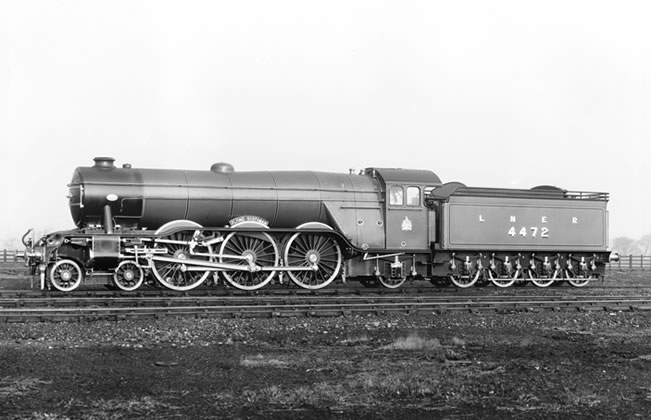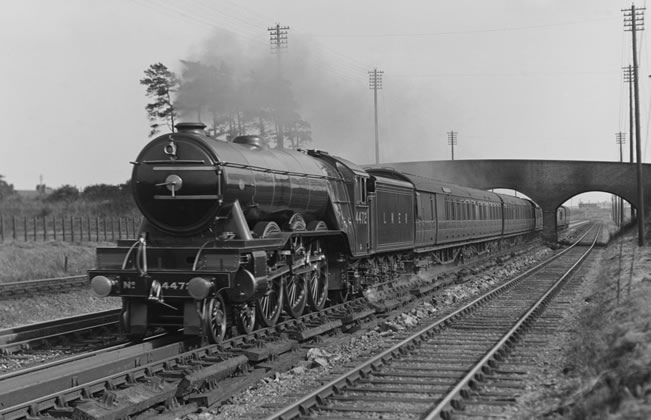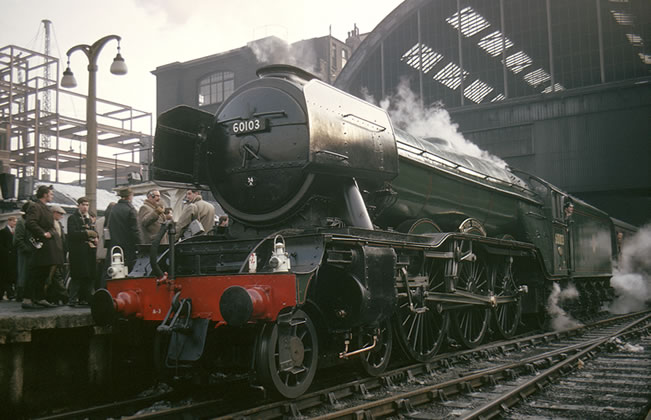What Color Smoke Does A Steam Train Make
One famous locomotive, many different get-ups—how should Flying Scotsman look?
Of all the locomotives in the National Collection, Flying Scotsman excites the most comment. For many she is the "most famous locomotive in the world" and should be resplendent in London and North Eastern Railway (LNER) apple green paint with the iconic number 4472. The question of what colour to present her in and what number she should carry is, therefore, a deeply emotive one and the National Railway Museum's recent announcement that the locomotive will return in her final British Railways guise (as far as practicable) has prompted much debate.
For all of Flying Scotsman's fame and celebrity there seems to be an equal amount of misunderstanding and myth. Some of the fame of the locomotive is due partly to it being confused with the famous London-Edinburgh Flying Scotsman train from which the engine took its name its name. By the 1920s the LNER were marketing the Flying Scotsman service as "The Most Famous Train in the World" and it may not be entirely co-incidental that the locomotive of the same name came to be known as "The Most Famous Locomotive in the World" in the 1960s, for the line between locomotive and train has often been blurred.


Arguably, it is Alan Pegler's restoration of Flying Scotsman to single chimney form, LNER colours and the number 4472 in 1963 that has perhaps most deeply ingrained the image of the locomotive on the national consciousness. But not was all as it seemed. Pegler himself said that to restore the engine to her original condition was "out of the question" so he settled for a compromise appearance of what he called "a typical LNER A3 of the 1930s". However, Flying Scotsman, built as an example of the A1 class in 1923, was only converted to the more powerful A3 form in 1947 by which time she had lost her iconic 4472 number and was then numbered 103 (with a short period as number 502 in between). Therefore, Flying Scotsman was not an A3 in the 1930s and never ran for the LNER in that form with the number 4472.
Moreover, it wasn't until 1954, well into the British Railways era, that the locomotive itself took on the full A3 shape: this was because the engine was converted to left hand drive at that time which necessitated the vacuum exhaust ejector pipe and the reversing rod to be placed on the left hand side of the locomotive rather than the right. This change made a noticeable difference to the locomotive's appearance as did the replacement of the rounded steam collector dome with the more elongated "banjo dome" (so called because it resembled the shape of a banjo).

With Alan Pegler retaining left hand drive the locomotive, although numbered 4472 and in LNER colours, showed noticeable differences in appearance from its classic LNER look (when it was still an A1). Indeed, there would be some debate about what is its classic LNER appearance: when it first appeared in 1923 it was numbered 1472 with a much smaller tender emblazoned with the letters "L&NER". Soon afterwards, to allow, the engine to access routes north of Newcastle the cab, dome and chimney were cut down in size and she was renumbered 4472. In 1928, to facilitate non-stop running, a new tender was added – high sided with a connecting corridor – so again the appearance changed. In 1936 Flying Scotsman lost her corridor tender as the A1s and A3s were then handing over operation of the non-stop services to the new A4 class.
Once converted to an A3 in 1947 (confusingly after a spell as an A10) Flying Scotsman was – after a period in wartime black – back in apple green but shorn of corridor tender and her 4472 number. With rail nationalisation in 1948 British Railways originally ran her in apple green and the number E103 but in 1949 she was repainted in BR Express Blue and carried the new number of 60103. In 1954, she was converted to left hand drive and painted in BR green (often called "Brunswick Green"). In 1959 her single chimney was converted to the double Kylchap style chimney that had been so successful on her A4 cousins such as world speed record holder Mallard. Due to the soft blast from the double chimney causing smoke to drift into the driver's eye line the final significant change was made when the German style smoke deflectors were added to the engine early in 1961 and at the same time the smoke box design was altered too with the top handrail being split to accommodate a dropped lamp bracket.
When Alan Pegler converted the loco back into single chimney form in February 1963 she conducted her test runs still in BR green and numbered 60103. But by this stage she had acquired a corridor tender again – originally from an A1/A3 sister engine Harvester but latterly running with A4 60034 Lord Farringdon. Another myth of Flying Scotsman is that she never ran with a corridor tender in BR green across BR metals – those two runs in February 1963, albeit in private ownership, demonstrate that was not the case.

There is a whole other story about changes in appearance during private ownership: red backed painted nameplates, green cylinder covers, double tenders, LNER coats of arms cab side, cowcatchers, bells, different identities for the film Agatha (1978), the A3 boiler being replaced with an A4 example, and the locomotive appearing in a hybrid BR-LNER form with smoke deflectors and double chimney. In her lifetime Flying Scotsman has had three classes (A1, A10 and A3), four colours, six numbers, nine different tenders and at least fifteen different boilers. So while the locomotive will return to steam in an appearance as close as possible to how she looked in January 1963 who knows whether this most chameleon of engines will once again undergo a change of appearance in future.
Read more about Flying Scotsman history and the latest restoration updates.
What Color Smoke Does A Steam Train Make
Source: https://blog.railwaymuseum.org.uk/many-guises-of-flying-scotsman/
Posted by: lainezdrinnera76.blogspot.com

0 Response to "What Color Smoke Does A Steam Train Make"
Post a Comment